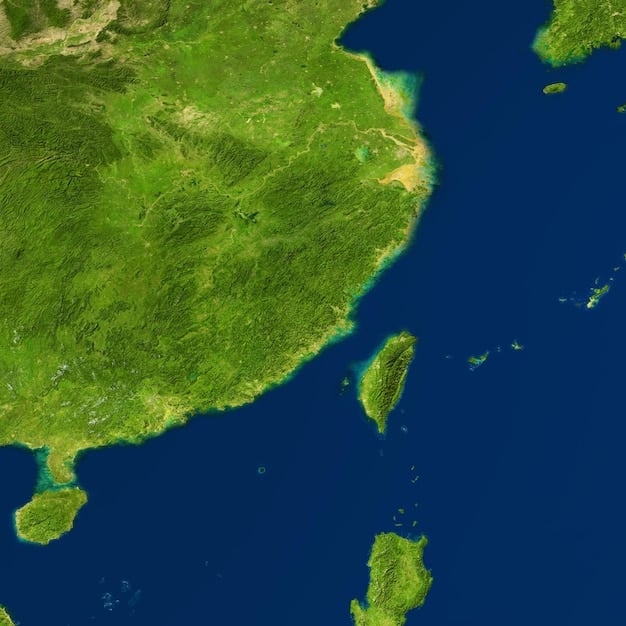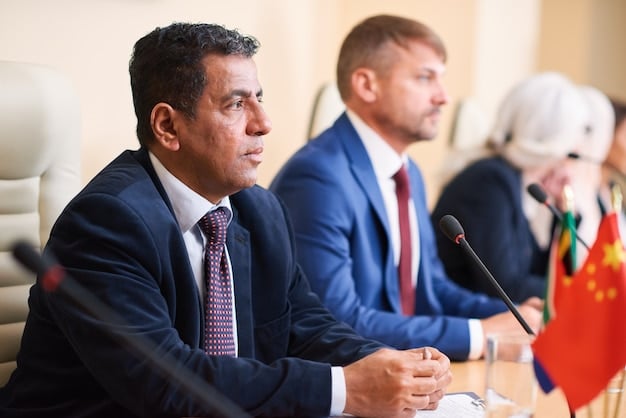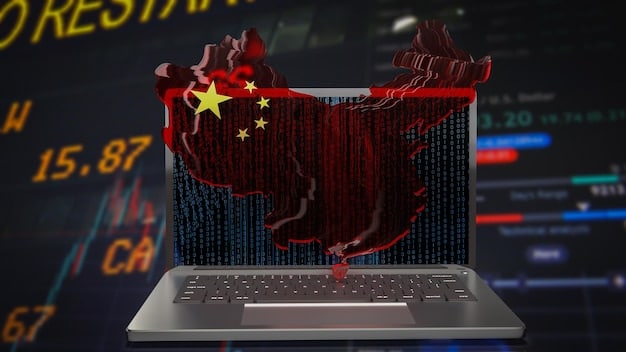US Strategy in the South China Sea: Addressing Rising Tensions in 6 Months

How will the US address the rising tensions in the South China Sea in the Next 6 Months? The US will likely employ a multi-faceted approach, combining diplomatic efforts, military presence, and economic strategies to counter China’s assertive actions and maintain regional stability.
The South China Sea remains a critical flashpoint in international relations. The question of how will the US address the rising tensions in the South China Sea in the Next 6 Months? is of paramount importance, not only for regional stability but also for the global balance of power. With China’s increasing assertiveness and competing territorial claims, the US faces a complex challenge requiring a nuanced and strategic approach. Let’s delve into the potential strategies the US might employ in the coming months.
Navigating Diplomatic Waters
Diplomacy is crucial for de-escalating conflict. The US likely engage in intensive diplomatic efforts to manage tensions in the South China Sea.
What role does dialogue play in easing tensions?
Strengthening Alliances
The US will fortify alliances to address the challenge.
Multilateral Engagements
The US promotes collective action through multilateral forums.
- The US seeks to foster dialogue.
- The US aims to promote adherence to international law.
- The US strengthens regional partnerships.
- The US advocates for peaceful resolution of disputes.
These efforts would aim to establish a common framework for behavior and prevent unilateral actions that could further escalate tensions. A collaborative approach is vital for long-term stability in the region.

Military Posture and Freedom of Navigation
Maintaining a strong military presence and upholding freedom of navigation are central to the US strategy. This presence is intended to deter aggressive behavior and reassure allies of the US commitment to regional security.
How does the US use its maritime power to influence the region?
Freedom of Navigation Operations (FONOPs)
The US conducts FONOPs to challenge excessive maritime claims.
Joint Military Exercises
The US engages in joint exercises to enhance interoperability with allies.
These operations and exercises send a clear message that the US will not accept violations of international law or attempts to unilaterally alter the status quo. A robust military presence is seen as a necessary counterbalance to China’s growing military power in the region.
Economic Strategies and Partnerships
Economic engagement and partnerships are important components of the US approach. Supporting economic development and promoting trade can contribute to regional stability and offer alternatives to Chinese economic dominance.
What are some key economic initiatives the US could pursue?
Promoting Trade and Investment
The US works to diversify economic opportunities in the region.
Supporting Infrastructure Development
The US assists in developing infrastructure to foster economic growth.
- Promoting sustainable development remains a priority.
- Encouraging transparent and fair trade practices are essential.
- Providing economic assistance to vulnerable countries is crucial.
- Fostering regional economic integration will enhance stability.
By offering attractive economic alternatives, the US aims to reduce the dependence of regional countries on China and promote a more balanced and sustainable economic landscape.
Cybersecurity and Information Warfare
In today’s interconnected world, cybersecurity and information warfare are increasingly important aspects of geopolitical competition. The US will likely focus on enhancing its capabilities in these domains to counter Chinese influence and protect its interests.
How can the US combat disinformation in the region?
Enhancing Cyber Defenses
The US strengthens its capabilities to protect against cyberattacks.
Countering Disinformation
The US works to expose and counter disinformation campaigns.

This includes strengthening cyber defenses, countering disinformation campaigns, and promoting a free and open internet. These efforts are aimed at protecting critical infrastructure, preserving democratic values, and ensuring a level playing field for information exchange.
Supporting Regional Governance and Legal Frameworks
The US supports regional governance and legal frameworks to promote stability. This involves working with regional organizations and advocating for the peaceful resolution of disputes through international law.
How can the US strengthen the role of international law?
Promoting the Rule of Law
The US emphasizes adherence to international law.
Strengthening Regional Institutions
The US supports regional organizations in promoting stability.
- The US promotes dialogue and cooperation.
- The US advocates for peaceful dispute resolution.
- The US strengthens the capacity of regional institutions.
- The US supports the implementation of international norms and standards.
By reinforcing these frameworks, the US aims to create a more predictable and stable environment in the South China Sea, reducing the risk of conflict and promoting peaceful cooperation.
Internal Political Dynamics and US Policy
US domestic politics will play a significant role. Domestic support will influence sustainability of initiatives.
How can internal dynamics affect stability?
Congressional Oversight
Congress plays a critical role in shaping US foreign policy.
Public Opinion
Public attitudes can influence the direction of US policy.
A strong consensus within the US government and among the public can provide a solid foundation for a consistent and effective approach to managing tensions in the South China Sea. Conversely, internal divisions could weaken the US position and undermine its credibility.
Conclusion of US Strategy in South China Sea
All these collaborative efforts highlight the US commitment to stability, and peaceful conflict resolution.
| Key Point | Brief Description |
|---|---|
| 🤝 Diplomacy | Engaging in dialogue to reduce conflict. |
| 🚢 Military Presence | Maintaining forces for regional security. |
| 💰 Economic Support | Promoting economic growth and partnerships. |
| 🌐 Cyber Security | Protecting digital assets from cyber threats. |
Frequently Asked Questions
▼
The main US interests include maintaining freedom of navigation, preserving regional stability, and upholding international law. The US also seeks to prevent any single country from dominating the region.
▼
The US views China’s actions, such as building artificial islands and asserting expansive maritime claims, as destabilizing and contrary to international law. The US opposes any attempts to unilaterally alter the status quo.
▼
Allies play a crucial role in the US strategy by providing support, enhancing interoperability, and sharing the burden of maintaining regional security. Joint exercises and coordinated diplomatic efforts are essential.
▼
The US could promote trade and investment, support infrastructure development, and provide economic assistance to regional countries to counter China’s economic influence and foster sustainable growth.
▼
Cybersecurity is integrated by enhancing cyber defenses, countering disinformation, and promoting a free and open internet to protect critical infrastructure and preserve democratic values in the region.
Conclusion
In conclusion, the US approach to addressing rising tensions in the South China Sea will require a comprehensive strategy encompassing diplomatic, military, economic, and cybersecurity measures. By working with allies, upholding international law, and promoting regional stability, the US aims to manage the challenges posed by China’s assertive actions and maintain a balance of power in this critical maritime region.





